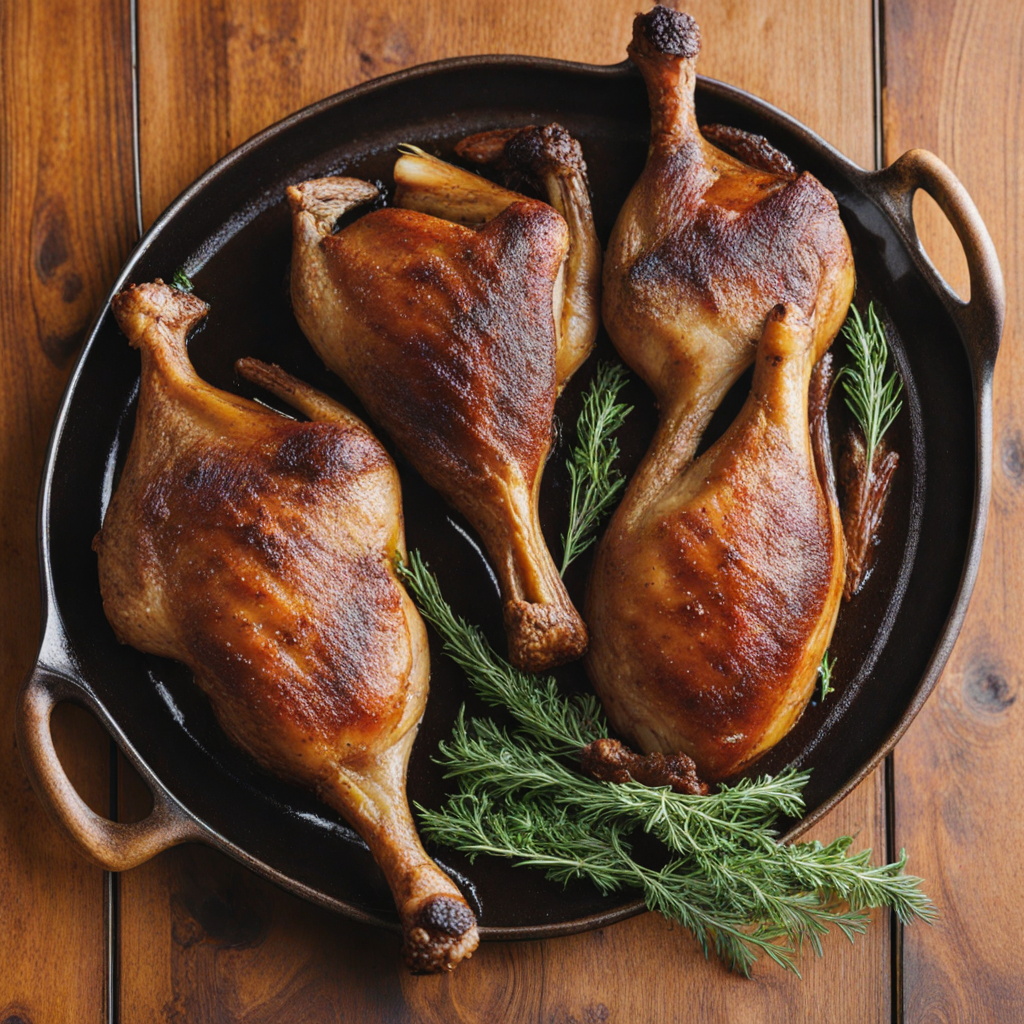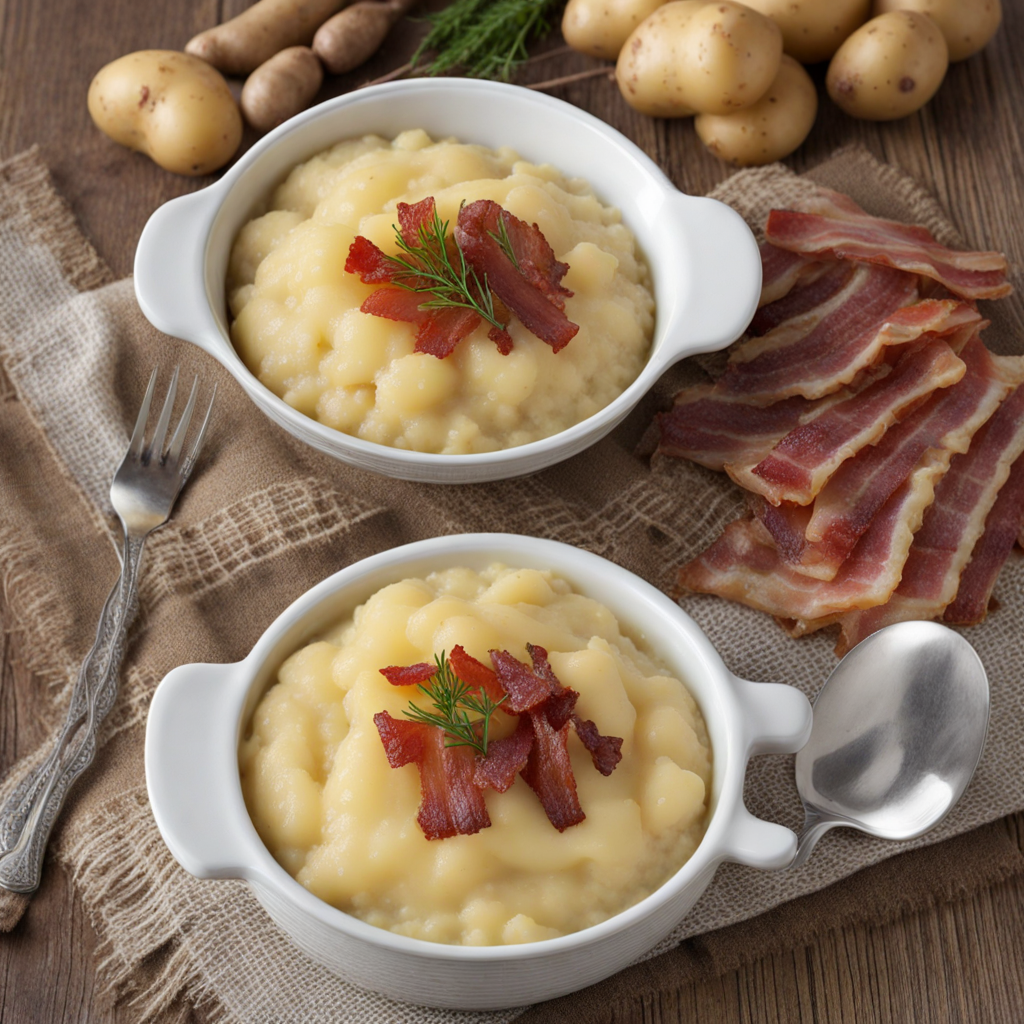Roasted Goose Legs
Roasted Goose Legs, a traditional Estonian dish, offer a unique and hearty flavor profile that captures the essence of rustic Eastern European cuisine. The preparation of these legs involves slow-roasting them to perfection, allowing the rich, succulent meat to develop a deep, savory taste. The skin becomes wonderfully crispy and golden, while the meat remains tender and juicy, making each bite a delightful experience. Seasoned with aromatic herbs and spices, such as thyme, garlic, and juniper berries, the dish is reminiscent of the lush Estonian countryside, where these ingredients are commonly found. Accompanying the roasted goose legs are often classic Estonian sides that enhance the overall meal. Traditional pairings might include creamy mashed potatoes or hearty, rustic rye bread, which serve to soak up the luscious juices from the goose. Additionally, pickled vegetables or a tangy cranberry sauce can provide a refreshing contrast to the richness of the meat, balancing the flavors and adding a bright note to the dish. The combination of textures and tastes creates a satisfying and comforting dish, perfect for gatherings and celebrations. The experience of savoring Roasted Goose Legs goes beyond just taste; it’s a journey into Estonian culture and heritage. This dish is often served during festive occasions, symbolizing warmth and hospitality. As you indulge in the savory meat, you’ll not only enjoy a delicious meal but also connect with the traditions of a country where food brings people together. Each bite tells a story of the land, the farmers, and the culinary practices that have been passed down through generations, making it a must-try for anyone looking to explore new culinary horizons.
How It Became This Dish
The History of Hanejalad: An Estonian Culinary Delight Origins of Hanejalad Hanejalad, a distinctive dish from Estonia, translates to "goose feet" in English, a name that evokes both curiosity and appetite. This dish is typically made by stuffing goose legs or feet with a savory mixture of ingredients, often including grains, vegetables, and spices, and then slow-cooking or baking them. To fully appreciate Hanejalad, we must delve into its origins and the cultural significance it holds within the context of Estonian cuisine. The roots of Hanejalad can be traced back to the agrarian lifestyle of the Estonian people, particularly during the medieval period when agriculture became the bedrock of the economy. Goose farming was common in Estonia, as these birds were well-suited to the local climate and landscape. They provided not only a source of meat but also down for warmth and feathers for various uses. The practice of using all parts of the animal is a hallmark of traditional Estonian cooking, and Hanejalad exemplifies this philosophy. Cultural Significance In Estonia, food is more than sustenance; it is a reflection of identity, history, and community. Hanejalad holds a special place in festive occasions, particularly during winter celebrations and family gatherings. The dish is often associated with harvest time and the onset of winter, when families would gather to enjoy hearty meals that reflect the fruits of their labor. Traditionally, Estonian cuisine has been shaped by various influences, including Nordic, German, and Russian culinary practices. Hanejalad, while distinctly Estonian, reveals the melding of these influences, particularly in its preparation and presentation. The dish is often accompanied by sides such as sauerkraut or potatoes, which have been staples in Estonian kitchens for centuries. Hanejalad also embodies the communal spirit of Estonian culture. Preparing this dish often involves family members working together, from the initial stages of butchering the goose to the final touches of seasoning and stuffing. This collaborative cooking not only strengthens family bonds but also reinforces a sense of cultural heritage, as recipes are passed down through generations. Development Over Time As Estonia navigated through various historical phases, including periods of foreign rule and independence, the culinary landscape, including Hanejalad, evolved. In the 19th century, with the rise of nationalism and a renewed interest in folk traditions, there was a resurgence of interest in traditional Estonian foods. Hanejalad, with its rustic roots and hearty flavors, became a symbol of national pride. The post-World War II era brought significant changes to Estonia, especially with the Soviet occupation. During this time, traditional foods faced challenges due to food shortages and the introduction of state-controlled agriculture. Ingredients became scarce, and many families had to adapt their recipes, often relying on whatever was available. Despite these challenges, the essence of Hanejalad remained intact, serving as a comforting reminder of home and heritage for many Estonians. In recent decades, Estonia has seen a culinary renaissance, with chefs and home cooks alike embracing traditional dishes while also experimenting with modern techniques and flavors. Hanejalad has been reimagined in contemporary kitchens, with some chefs opting for gourmet presentations or incorporating fusion elements. However, the core of the dish, its connection to the land and its cultural significance, remains unchanged. Today, Hanejalad can be found in both home kitchens and restaurants across Estonia, particularly during the winter months. It is often featured at food festivals and culinary events that celebrate Estonian heritage. The dish has also gained attention outside Estonia, as culinary enthusiasts and food historians explore the rich tapestry of Baltic cuisine. Conclusion Hanejalad is more than just a dish; it is a testament to the resilience and creativity of the Estonian people. Its history reflects the changing tides of culture and society, yet it remains a cherished symbol of national identity and communal spirit. As Estonia continues to evolve, Hanejalad serves as a delicious reminder of the past, a bridge connecting generations through the simple act of sharing a meal. In a world increasingly dominated by globalization and fast food, Hanejalad stands as a celebration of local ingredients, traditional cooking methods, and the enduring value of family and community. Whether served at a festive gathering or enjoyed in a quiet family meal, Hanejalad encapsulates the heart of Estonian cuisine, inviting us all to savor the flavors of history.
You may like
Discover local flavors from Estonia







